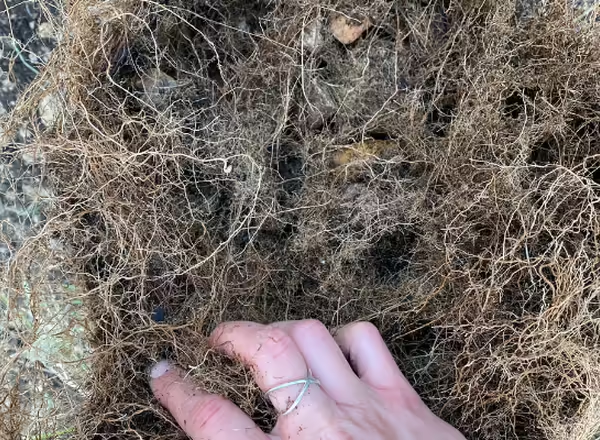
Before the first hard frost came at the end of October, I planted many native plants around our new house. I brought some of my favorite plants with me in our move and was determined to get them planted this fall. One of the pots I brought with me had a Little Bluestem plant in it that I have been growing for at least 5 years. I never intended to keep it in the pot for that long, but after a few years my curiosity started to grow. How long can I keep this grass in the pot, and when I do decide to put it in the ground, what is the root system going to look like?
You may or may not have seen the very popular sketch drawings of the roots of prairie wildflowers and grasses, showing how depending on species, their roots can stretch between 3 and 15 deep in the soil. Or you may have seen some amazing photography of the roots of prairie plants that were grown in large trash cans or tubes and carefully excavated. Or maybe you’ve visited one of the many museum specimens of these roots. Check out the Tallgrass Prairie Center to learn more about their Prairie Roots Project to learn more.
On a small scale, this is what I was trying to replicate in my backyard. So, what did I find?
Taking a look underground
My pot measured 16 inches in diameter with a depth of 14 inches. I dumped out the whole core of soil, and what I found was nearly a solid wall of roots. Apparently I had put a layer of rocks in the bottom of the pot to help weigh it down so it didn’t tip over in the wind, and the roots essentially engulfed all of the rocks. There was no soil in the bottom few inches of the pot, it was entirely roots and rocks.
Since I know how long these roots can grow, I was expecting to find roots wrapped around the bottom of the pot, like I find in my houseplants that are rootbound. I didn’t find this. Instead, what I found was an intensely dense collection of roots filling the pot.
Looking into grass roots and how they work, I learned a few new things. While warm-season prairie grasses can grow roots between 4 and 8 feet deep, most of the roots they produce are concentrated in the top 12 inches of soil. This would explain why in many of the diagrams and pictures of long prairie roots you see them in the shape of an ice cream cone: very dense on top but becoming sparser the longer they grow.
The roots of these grasses are fibrous, in comparison to a taproot that you might find in flowering plants like a dandelion. They form a dense mat of thousands of individual roots. This increased surface area helps with water and nutrient uptake and provides more opportunities for association with mycorrhizal fungi.
Some of this is probably what I was seeing in my Little Bluestem plant, although it being restricted to only having about a foot of root growing space also had an impact on how the roots grew to some degree.
What does this mean?
There’s a lot going on underground that we aren’t aware of, especially since most of the biomass of these grasses is underground. These plants create incredible, resilient root systems that help them withstand changing environmental conditions and disturbance year after year, as well as build a healthy soil community. Adding these prairie grasses into your home landscape can help you build better soil. Try it out!
Learn more
This blog post by the Prairie Ecologist looks into the function of roots and references some of the research behind it.


Never miss a new post! Sign up for our email list.
ABOUT THE AUTHOR: Erin Garrett is a Natural Resources, Environment, and Energy Educator for University of Illinois Extension serving Alexander, Johnson, Massac, Pulaski, and Union counties. Erin develops and delivers high impact programming to adults and youth to help them develop an appreciation for natural resources and to empower them to make small changes to positively impact the environment. Erin’s programming focuses on why homeowners should consider choosing native plants, how to support native pollinators, how to identify grasses, how to identify and manage invasive species, and developing an appreciation for prairie ecosystems.
ABOUT THE BLOG: Grasses at a Glance dives into grass identification, focusing on tips and tricks that make grass identification possible. Get information about native and non-native species, how to tell look-alikes apart, and which grasses you can find in Illinois.